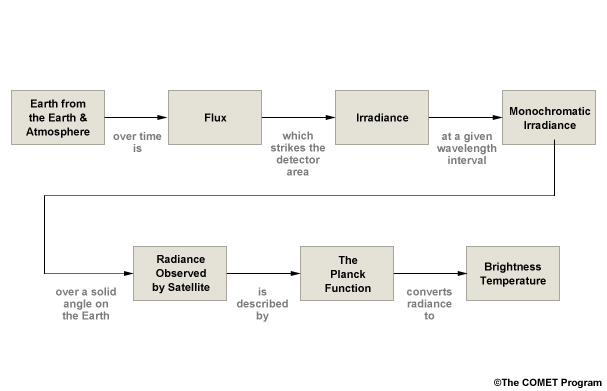Definition of Radiance
Table of Contents
- Definition of Radiance
- Introduction
- Radiance Equation
- Planck Radiance Equation and BT Equation
- Energy in Joules
- Flux
- Irradiance
- Monochromatic Irradiance
- Solid Angle
- Satellite Viewing at Large Local Zenith Angles
- Viewing Imagery Beyond 60 Degrees Local Zenith Angle
- Planck Radiance Equation
- Planck Equation and Brightness Temperature
- The Planck Function, Wavelength, and Temperature
- The Planck Function, Wavelength, and Temperature
- Summary
- Concept Map
Definition of Radiance
Definition of Radiance »Introduction
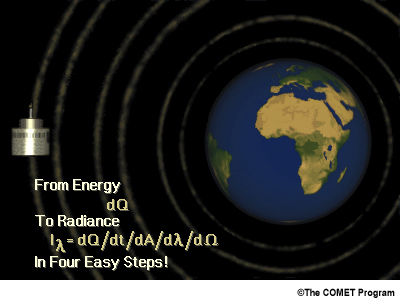
From energy to radiance in four easy steps! This section of the conceptual model explains what the satellite is sensing from the earth in terms of the different units of radiation. By gaining an understanding of the derivation of radiance from reflected and emitted energy, you will be able to match atmospheric processes to the equations that represent them.
Definition of Radiance »Radiance Equation
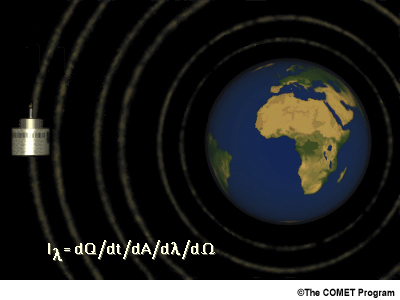
The equation for radiance is central to understanding how the satellite senses energy and how that data is translated into different products. In the following screens, each term of the radiance equation will be explained.
Definition of Radiance »Planck Radiance Equation and BT Equation
The Planck Radiance Equation and Brightness Temperature equation is shown below. The terms will be explained in more detail in the rest of this section.
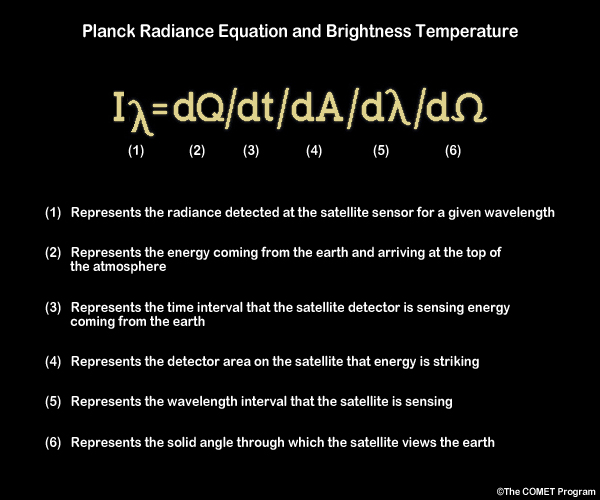
Definition of Radiance »Energy in Joules
Remote sensing seeks to accurately measure electromagnetic energy radiating from the earth and atmosphere.
In the MKS system, energy is expressed in Joules.
Notice that energy is being emitted continuously in all directions from the earth.
Definition of Radiance »Flux
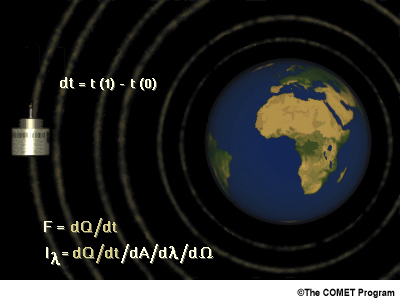
Flux is the amount of energy per unit time interval, detected by the satellite.
Energy from the earth is measured from time zero to time one. This interval is represented by the dt term in both equations. Hence, flux is the energy detected by the satellite over time expressed in Joules per second or Watts.
Definition of Radiance »Irradiance
The flux, or energy per unit time, is sensed by a detector of fixed dimensions on the satellite.
The energy detected on this area is called irradiance (E). Since it is referring to an area, irradiance is expressed in Watts per metre squared or Joules per second per metre squared.
Definition of Radiance »Monochromatic Irradiance
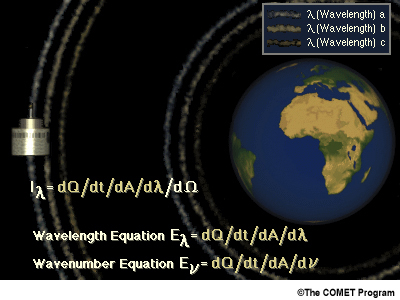
The earth is emitting energy at many wavelengths. The satellite is designed to measure the irradiance of narrow wavelength intervals. Energy detected within this interval is called the monochromatic or narrow band irradiance (E(λ)).
Sometimes atmospheric scientists refer to wavenumbers, the number of wavelengths that fit into one centimetre, represented by the ν (pronounced nu). Hence, the monochromatic irradiance equation can be expressed using wavelength or wavenumbers.
Definition of Radiance »Solid Angle
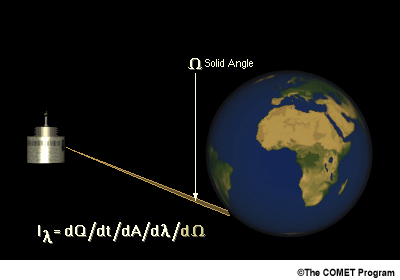
The satellite telescope collects the energy over a certain solid angle, which is expressed in steradians. Measuring the monochromatic irradiance over this solid angle constitutes the radiance. Hence the units for radiance are Watts per metre squared per wavelength interval per steradian.
Definition of Radiance »Satellite Viewing at Large Local Zenith Angles
Although the solid angle stays constant during scanning, the footprint or field of view on the earth's surface changes based on where the satellite is viewing. The footprint is larger when the satellite is at the horizontal and vertical edges of its scanning range. As the footprint grows, the resolution of the images lessens. The lowered resolution degrades images at very large local zenith angles.
Definition of Radiance »Viewing Imagery Beyond 60 Degrees Local Zenith Angle
Although resolution is lowered at local zenith angles beyond 60 degrees, valuable information can be obtained by using Meteosat imagery at these high latitudes. This 24-hour visible loop shows a large ice area near Greenland. Notice clouds moving across the ice area early in the loop.
Definition of Radiance »Planck Radiance Equation
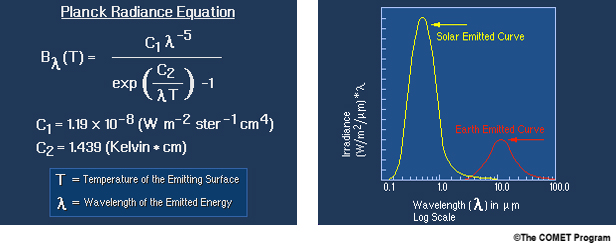
The radiance coming from the earth and atmosphere is described by the Planck function given in the left panel. Here Planck radiance is given as a function of wavelength interval and temperature. The right panel shows energy curves for incoming solar and earth emitted radiation. The areas under both curves are equal (note the logarithmic x-axis), showing that there is thermal equilibrium between the earth and sun on an annual time scale. The two curves are graphed on a logarithmic scale. Without this scale, both graphs would not fit on one page.
Definition of Radiance »Planck Equation and Brightness Temperature
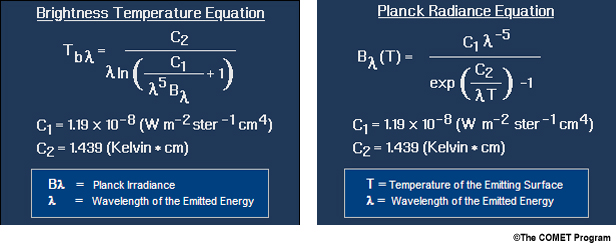
The Planck equation expresses radiance as a function of wavelength and temperature. When given a radiance measurement, meteorologists often refer to the associated brightness temperature. The equation on the left is an inversion of the Planck equation which expresses brightness temperature as a function of Planck radiance and wavelength.
Definition of Radiance »The Planck Function, Wavelength, and Temperature
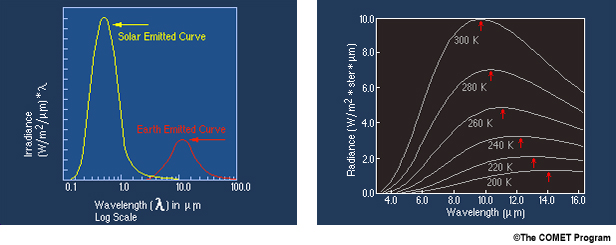
At a given wavelength, the radiance of an object depends only on its temperature. The lines (note arrows) show Planck maxima at different temperatures. As the temperature of the emitting surface increases, the Planck curve maxima shifts to shorter wavelengths (known as Wien’s Law).
As the Planck curve maxima shifts to shorter wavelengths, the temperature of the emitting surface _______. Select the phrase that completes the sentence.
The correct answer is C.
The temperature increases. This is known as Wien’s Law, which states that the wavelength of peak emission of a blackbody at temperature T equals 2897 divided by the wavelength (in µm).
Definition of Radiance »The Planck Function, Wavelength, and Temperature
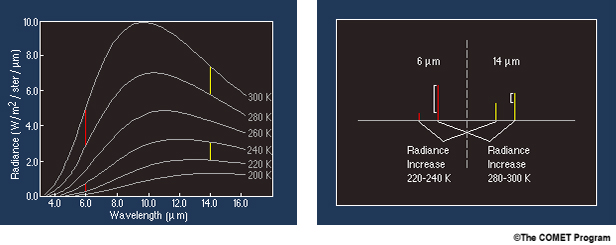
Also as wavelength decreases, the radiance increases more rapidly with temperature. For example, examine the change in radiance at 6 and 14 µm from 220 to 240 K and from 280 to 300 K. The bars on the right represent the radiance increases at these two wavelengths. Notice that the radiance increased almost 400% at 6 µm while the radiance increased only 50% at 14 µm. This radiance property is the basis for detecting fires and other hot areas using the shortwave infrared channel, centred at 3.9 µm. Note that this channel is available on the Meteosat Second Generation satellite.
Definition of Radiance »Summary
Summary:
- This section explains radiance and Planck's Law
- Flux is energy per time; irradiance is flux per area; radiance is irradiance per wavelength interval and solid angle
- Radiance is a function of wavelength and temperature only
- Brightness temperature is specified by radiance and wavelength
- As temperature increases, the peak of the Planck curve shifts to shorter wavelengths
- At shorter wavelengths, radiance increases more rapidly with temperature than at longer wavelengths
Concept Map
Concept Map »Question
Select the units for each quantity (use the selection box to choose the answer that best completes the statement). After you finish click Done button.
W = Watts
ster = steradians
m = metres
m² = square metres
s = seconds
μm = micrometres
J = Joules
K = Kelvin
Concept Map »Concept Map
Review the terms of the radiance equation and the derivation of brightness temperature. If you want more information about any of the terms, click on the boxes themselves. (You will be taken to the related page; click the Back button to return to this page.)
